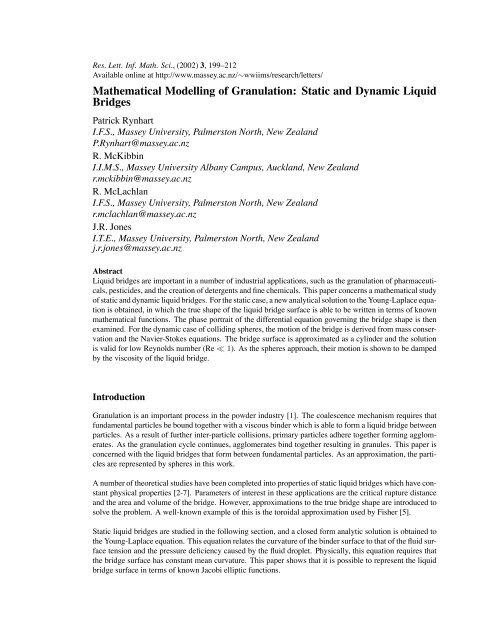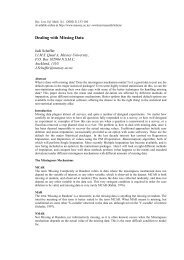Mathematical Modelling of Granulation: Static and Dynamic Liquid ...
Mathematical Modelling of Granulation: Static and Dynamic Liquid ...
Mathematical Modelling of Granulation: Static and Dynamic Liquid ...
You also want an ePaper? Increase the reach of your titles
YUMPU automatically turns print PDFs into web optimized ePapers that Google loves.
Res. Lett. Inf. Math. Sci., (2002) 3, 199–212<br />
Available online at http://www.massey.ac.nz/∼wwiims/research/letters/<br />
<strong>Mathematical</strong> <strong>Modelling</strong> <strong>of</strong> <strong>Granulation</strong>: <strong>Static</strong> <strong>and</strong> <strong>Dynamic</strong> <strong>Liquid</strong><br />
Bridges<br />
Patrick Rynhart<br />
I.F.S., Massey University, Palmerston North, New Zeal<strong>and</strong><br />
P.Rynhart@massey.ac.nz<br />
R. McKibbin<br />
I.I.M.S., Massey University Albany Campus, Auckl<strong>and</strong>, New Zeal<strong>and</strong><br />
r.mckibbin@massey.ac.nz<br />
R. McLachlan<br />
I.F.S., Massey University, Palmerston North, New Zeal<strong>and</strong><br />
r.mclachlan@massey.ac.nz<br />
J.R. Jones<br />
I.T.E., Massey University, Palmerston North, New Zeal<strong>and</strong><br />
j.r.jones@massey.ac.nz<br />
Abstract<br />
<strong>Liquid</strong> bridges are important in a number <strong>of</strong> industrial applications, such as the granulation <strong>of</strong> pharmaceuticals,<br />
pesticides, <strong>and</strong> the creation <strong>of</strong> detergents <strong>and</strong> fine chemicals. This paper concerns a mathematical study<br />
<strong>of</strong> static <strong>and</strong> dynamic liquid bridges. For the static case, a new analytical solution to the Young-Laplace equation<br />
is obtained, in which the true shape <strong>of</strong> the liquid bridge surface is able to be written in terms <strong>of</strong> known<br />
mathematical functions. The phase portrait <strong>of</strong> the differential equation governing the bridge shape is then<br />
examined. For the dynamic case <strong>of</strong> colliding spheres, the motion <strong>of</strong> the bridge is derived from mass conservation<br />
<strong>and</strong> the Navier-Stokes equations. The bridge surface is approximated as a cylinder <strong>and</strong> the solution<br />
is valid for low Reynolds number (Re ≪ 1). As the spheres approach, their motion is shown to be damped<br />
by the viscosity <strong>of</strong> the liquid bridge.<br />
Introduction<br />
<strong>Granulation</strong> is an important process in the powder industry [1]. The coalescence mechanism requires that<br />
fundamental particles be bound together with a viscous binder which is able to form a liquid bridge between<br />
particles. As a result <strong>of</strong> further inter-particle collisions, primary particles adhere together forming agglomerates.<br />
As the granulation cycle continues, agglomerates bind together resulting in granules. This paper is<br />
concerned with the liquid bridges that form between fundamental particles. As an approximation, the particles<br />
are represented by spheres in this work.<br />
A number <strong>of</strong> theoretical studies have been completed into properties <strong>of</strong> static liquid bridges which have constant<br />
physical properties [2-7]. Parameters <strong>of</strong> interest in these applications are the critical rupture distance<br />
<strong>and</strong> the area <strong>and</strong> volume <strong>of</strong> the bridge. However, approximations to the true bridge shape are introduced to<br />
solve the problem. A well-known example <strong>of</strong> this is the toroidal approximation used by Fisher [5].<br />
<strong>Static</strong> liquid bridges are studied in the following section, <strong>and</strong> a closed form analytic solution is obtained to<br />
the Young-Laplace equation. This equation relates the curvature <strong>of</strong> the binder surface to that <strong>of</strong> the fluid surface<br />
tension <strong>and</strong> the pressure deficiency caused by the fluid droplet. Physically, this equation requires that<br />
the bridge surface has constant mean curvature. This paper shows that it is possible to represent the liquid<br />
bridge surface in terms <strong>of</strong> known Jacobi elliptic functions.
200 R.L.I.M.S. Vol. 3, April, 2002<br />
Figure 1: Illustration <strong>of</strong> the static liquid bridge geometry. Dimensional variables are used (as in equations (1) <strong>and</strong> (2)).<br />
Acontact angle <strong>of</strong> θ =10 o , α =40 o , β =38 o .The radius <strong>of</strong> particle A is rA =0.1 mm <strong>and</strong> particle B rB =0.15 mm.<br />
The length <strong>of</strong> the bridge is 0.12 mm.<br />
<strong>Static</strong> Bridges<br />
Consider figure 1 which illustrates a liquid bridge with cylindrical symmetry between two spherical particles<br />
‘A’ <strong>and</strong> ‘B’ <strong>of</strong> radii rA <strong>and</strong> rB. Coordinates r <strong>and</strong> x define the position <strong>of</strong> the liquid bridge surface along<br />
with the radii <strong>of</strong> curvature r1 <strong>and</strong> r2 which lie in the r − x <strong>and</strong> r − y planes respectively. The curvature<br />
in the r-x plane is therefore given by 1<br />
1<br />
,<strong>and</strong>thecurvature in the r-y plane by .Allowing ∆p to denote<br />
r1 r2<br />
the pressure deficiency caused by the presence <strong>of</strong> the liquid droplet (∆p >0 when the internal pressure <strong>of</strong><br />
the bridge is higher than the external (ambient) pressure), the Young-Laplace equation relates the surface<br />
tension <strong>of</strong> the binder γ to the pressure difference ∆p <strong>and</strong> the mean curvature <strong>of</strong> the bridge surface,<br />
<br />
1<br />
γ +<br />
r1<br />
1<br />
<br />
=∆p. (1)<br />
r2<br />
Gravity does not appear in (1) as the mass <strong>of</strong> the liquid bridge is very small in comparison with the surface<br />
tension force between particles. Upon substitution <strong>of</strong> the vector calculus results for 1 1 <strong>and</strong> (see [8] for<br />
r1 r2<br />
details), equation (1) can be written<br />
<br />
<br />
1<br />
γ<br />
= −∆p. (2)<br />
r ′′<br />
(1 + r ′2 ) 3/2 −<br />
r(1 + r ′2 ) 1/2<br />
Equation (2) can be non-dimensionalised by introducing variables X = x<br />
r<br />
σ <strong>and</strong> R = σ ,where σ is the scaling<br />
variable relating non-dimensional <strong>and</strong> dimensional variables. In the case <strong>of</strong> figure 1, σ can be chosen as<br />
either rA or rB. Also, a non-dimensional pressure difference ∆P = ∆pσ<br />
γ is introduced, enabling the nondimensional<br />
version <strong>of</strong> (2) to be written as<br />
R ′′<br />
(1 + R ′2<br />
) 3/2 −<br />
1<br />
R(1 + R ′2 = −∆P. (3)<br />
) 1/2<br />
In (3) the notation R ′ = dR<br />
dX <strong>and</strong> R′′ = d2R dX2 has been adopted. Initial values for the bridge height R0 <strong>and</strong><br />
tangent R ′ 0 (occurring on particle A above) are specified. The angle which the bridge makes contact with the<br />
tangent plane to the spheres is the contact angle θ <strong>and</strong> is specified for a given problem. The starting value<br />
for the bridge height (occurring at X0)is<br />
R0 = rA<br />
σ sin α = RA sin α
P. Rynhart et al., <strong>Mathematical</strong> <strong>Modelling</strong> <strong>of</strong> <strong>Granulation</strong> 201<br />
<strong>and</strong> that <strong>of</strong> the slope at the point <strong>of</strong> contact is<br />
R0 ′ = cot(α + θ).<br />
Using the information above, an analytic solution to equation (3) is possible upon making the substitution<br />
Differentiating U with respect to X gives<br />
U =<br />
<br />
1+R ′2 − 1<br />
2<br />
. (4)<br />
dU<br />
dX = − R′ R ′′<br />
3 . (5)<br />
1+R ′2 2<br />
Rearranging the right h<strong>and</strong> sides <strong>of</strong> (4) <strong>and</strong> (5), substituting these equations into (5) <strong>and</strong> applying the chain<br />
), (3) can be written as the following first order differential equation,<br />
rule (where dU dX<br />
dX dR<br />
Integrating (6) gives<br />
= dU<br />
dR<br />
dU U<br />
+ =∆P. (6)<br />
dR R<br />
U =<br />
R ∆P<br />
2<br />
where the constant <strong>of</strong> integration E is the energy <strong>of</strong> the liquid bridge surface. Equation (3) defines a Hamiltonian<br />
dynamical system <strong>and</strong> hence the energy E is conserved. By combining (4) <strong>and</strong> (7),<br />
<br />
<br />
E = R<br />
1 R∆P<br />
−<br />
1+R ′2 2<br />
. (8)<br />
Substituting (4) into (7) <strong>and</strong> rearranging gives R ′ as<br />
R ′ = dR<br />
dX<br />
= ±<br />
+ E<br />
R<br />
<br />
R2 − ∆PR2 + E2<br />
∆P R 2<br />
2<br />
2<br />
+ E<br />
Rearranging the above, the shape <strong>of</strong> the bridge (where R0 ≤ R ≤ R1)isgivenby the integral<br />
X =<br />
If E =0then (9) can be solved to give<br />
R<br />
R0<br />
<br />
∆PR 2<br />
2<br />
+ E<br />
R 2 − ∆PR 2<br />
2<br />
X 2 + R 2 2 2<br />
=<br />
∆P<br />
showing that the liquid bridge then has a spherical shape.<br />
(7)<br />
+ E2 dR. (9)<br />
If E = 0, (9) can be completed using integral tables [9]. The following parametric solution in terms <strong>of</strong> X<br />
is produced,<br />
<br />
R<br />
X = F<br />
ξ ,χ<br />
<br />
R0<br />
− F<br />
ξ ,χ<br />
<br />
η + 2E<br />
<br />
∆P η<br />
<br />
R0<br />
+ η E<br />
ξ ,χ<br />
<br />
R<br />
− E<br />
ξ ,χ<br />
(11)<br />
(10)
202 R.L.I.M.S. Vol. 3, April, 2002<br />
φ<br />
100<br />
80<br />
60<br />
40<br />
20<br />
0<br />
−20<br />
−40<br />
−60<br />
−80<br />
0.5<br />
0.4<br />
0.3<br />
0.1<br />
0.2<br />
0<br />
−100<br />
0 0.5 1 1.5 2 2.5<br />
R ∆ P<br />
3 3.5 4 4.5 5<br />
where<br />
<strong>and</strong><br />
−1<br />
−2<br />
−3<br />
−4<br />
−5<br />
−6<br />
−7<br />
Figure 2: Phase portrait for ∆P >0. Hereφ = arctan R ′ . Contour labels are values <strong>of</strong> E ∆P .<br />
η 2 ,ξ 2 =<br />
2<br />
(∆P ) 2<br />
<br />
(1 − E∆P ± √ <br />
1 − 2E∆P<br />
ξ = χ/η<br />
such that ξ ≤ R ≤ η,<strong>and</strong>where E <strong>and</strong> F are Jacobi elliptic functions <strong>of</strong> the first kind [9]. Equation (11) defines<br />
the shape (R) <strong>of</strong>abridge parameterised by the position X, wheretheenergylevels E are determined<br />
from (8). Upon consideration <strong>of</strong> the discriminant <strong>of</strong> the the quadratic in X 2 <strong>of</strong> (9), it can be shown that<br />
E ∆P < 1<br />
2 .<br />
Although equation (11) represents the liquid bridge configuration in terms <strong>of</strong> known mathematical functions,<br />
difficulty arises when attempting to integrate this solution to determine properties such as the bridge surface<br />
area <strong>and</strong> volume. In order to solve the problem in which certain properties are held constant, approximations<br />
to the bridge surface, or a numerical scheme, must be used (as in [2-6]).<br />
Phase Portrait<br />
The energy level E is related to the height <strong>and</strong> slope <strong>of</strong> the bridge surface (R, R ′ )byequation (8). Boundary<br />
conditions on R <strong>and</strong> R ′ , along with the pressure difference ∆P determine the contour for a particular liquid<br />
bridge. Generic contours, characterising all liquid bridge configurations, can be obtained from (8) by scaling.<br />
Upon introducing ˜ R = R ∆P <strong>and</strong> ˜ X = X ∆P ,itfollows that<br />
E ∆P = ˜ ⎛<br />
R ⎝<br />
1<br />
<br />
1+ ˜ R ′2<br />
− ˜ ⎞<br />
R<br />
⎠ .<br />
2<br />
(12)<br />
An angle φ measured with respect to the horizontal coordinate X is introduced where R ′ <br />
= tan φ <strong>and</strong> therefore<br />
1+R ′2<br />
= sec φ. Interms <strong>of</strong> φ,equation (12) becomes<br />
E ∆P = ˜ <br />
R cos φ − ˜ <br />
R<br />
2<br />
for ∆P >0, (13a)
P. Rynhart et al., <strong>Mathematical</strong> <strong>Modelling</strong> <strong>of</strong> <strong>Granulation</strong> 203<br />
φ<br />
100<br />
0<br />
80<br />
60<br />
40<br />
20<br />
0<br />
−20<br />
−40<br />
−60<br />
−80<br />
0<br />
1 2<br />
3<br />
−100<br />
0 0.5 1 1.5 2 2.5<br />
R ∆ P<br />
3 3.5 4 4.5 5<br />
φ<br />
(a) Phase portrait for ∆P
204 R.L.I.M.S. Vol. 3, April, 2002<br />
<strong>and</strong><br />
E ∆P = ˜ <br />
R cos φ + ˜ <br />
R<br />
2<br />
for ∆P 0, periodic solutions exist<br />
for |φ| < 90 o .Forthiscase, the shape <strong>of</strong> the liquid surface is that <strong>of</strong> a ‘wavy’ cylinder. For the contour<br />
E ∆P =0.5, φ ≡ 0 o <strong>and</strong> this corresponds to the cylinder solution. For E ∆P < 0, theliquid surface<br />
begins with initial height R0, <strong>and</strong> curves upwards reaching a maximum height Rmax >R0. The critical<br />
contour at φ =90 o (E ∆P =0)isthe sphere described in (10), which separates the cylinder <strong>and</strong> upwardly<br />
curved solutions.<br />
When the pressure inside the bridge is equal to the external (ambient) pressure (as in figure 3(b)), two types<br />
<strong>of</strong> liquid bridges occur : for |φ| = 90 o ,the bridges start with initial height R0 <strong>and</strong> then curve inward achieving<br />
a height Rmin
P. Rynhart et al., <strong>Mathematical</strong> <strong>Modelling</strong> <strong>of</strong> <strong>Granulation</strong> 205<br />
Neglecting inertial terms, that is assuming Re ≪ 1, the momentum equations from [11] reduce to<br />
0=− ∂P<br />
∂r + µ ∂2vr 1 ∂vr<br />
+<br />
∂r2 r ∂r + ∂2vr ∂z<br />
0=− ∂P<br />
∂z − ρg + µ ∂2vz 1<br />
+<br />
∂r2 r<br />
r 2<br />
2 − vr<br />
∂vz<br />
∂r + ∂2vz ∂z2 where P = P (r, z) is the pressure difference between the inside <strong>and</strong> outside <strong>of</strong> the liquid bridge, defined<br />
to be positive when the pressure is higher internally. To make progress on this problem, an approximation<br />
that vz ≪ vr is introduced. Physically this means that the bridges must have a small volume, <strong>and</strong> that a<br />
small gap distance h must separate the particles when compared to the volume <strong>and</strong> radius <strong>of</strong> a fundamental<br />
particle with radius R. Since vz ≪ vr, <strong>and</strong> because gravity is not considered in this approximation, only<br />
equation (15) is applicable to the solution.<br />
Figure 4: Figure showing two general surfaces that are approaching each other, described by z1 = h1(r, t) <strong>and</strong> z2 =<br />
h2(r, t), separated by a distance h0(t) which is the distance <strong>of</strong> closest approach between the two surfaces.<br />
Velocity Pr<strong>of</strong>ile<br />
Consider the volume flow rate Q <strong>of</strong> fluid displaced when surfaces z1 <strong>and</strong> z2 move toward each other. Since<br />
the surfaces have cylindrical symmetry,<br />
Q =<br />
h2(r,t)<br />
h1(r,t)<br />
(15)<br />
(16)<br />
2πr vr dz. (17)<br />
To determine Q,wemanipulate (17) by taking the partial derivative <strong>of</strong> Q with respect to r,<strong>and</strong>then dividing<br />
through by r. Upon completing this, we obtain<br />
1<br />
r<br />
∂<br />
∂r<br />
+ 2π<br />
r<br />
Z h2(r,t)<br />
h1(r,t)<br />
∂h2<br />
∂r<br />
! 2π<br />
2πrvr dz =<br />
r<br />
Z h2(r,t)<br />
h1(r,t)<br />
∂<br />
∂r (rvr)dz<br />
∂h1<br />
vr(r, h2(r, t),t) − vr(r, h1(r, t),t)<br />
∂r<br />
where the second term in (18) arises upon application <strong>of</strong> the fundamental theorem <strong>of</strong> calculus <strong>and</strong> the chain<br />
rule. Now, since the fluid is unable to move through the surfaces,<br />
vr(r, h1(r, t),t)=vr(r, h2(r, t),t)=0.<br />
(18)
206 R.L.I.M.S. Vol. 3, April, 2002<br />
Figure 5: The scenario in which two approaching equi-sized spheres, <strong>of</strong> radius R,are connected together via a dynamic<br />
liquid bridge shown by the dotted lines.<br />
This reduces (18) to<br />
Substituting (14) into (19) yields<br />
h2(r,t)<br />
1 ∂Q 2π ∂<br />
=<br />
r ∂r r h1(r,t) ∂r (rvr)dz. (19)<br />
h2(r,t)<br />
1 ∂Q<br />
∂vz<br />
= −2π<br />
r ∂r h1(r,t) ∂z dz<br />
= −2π (vz(r, h2(r, t),t)<br />
− vz(r, h1(r, t),t))<br />
The separation functions h1(r, t) <strong>and</strong> h2(r, t) can be written as the sum <strong>of</strong> a time dependent function h0(t),<br />
changing as the surfaces move, <strong>and</strong> a radial function f1(r) <strong>and</strong> f2(r) as shown in figure 4. It is then possible<br />
to write h1(r, t) =− 1<br />
2 h0(t)+f1(r) <strong>and</strong> h2(r, t) = 1<br />
2 h0(t)+f2(r). Now<br />
so it follows that equation (20) is equivalent to<br />
vz(r, h1(r, t),t)= ∂h1<br />
(r =0,t)=−1<br />
∂t 2 ˙ h0(t)<br />
vz(r, h2(r, t),t)= ∂h2<br />
(r =0,t)=1<br />
∂t 2 ˙ h0(t),<br />
1 ∂Q<br />
= −2π<br />
r ∂r<br />
1<br />
2 ˙ h0(t) − −1<br />
2 ˙ h0(t)<br />
(20)<br />
<br />
= −2π ˙ h0(t). (21)
P. Rynhart et al., <strong>Mathematical</strong> <strong>Modelling</strong> <strong>of</strong> <strong>Granulation</strong> 207<br />
Therefore<br />
Q(r, t) =−2π<br />
r<br />
For laminar flow, a parabolic radial velocity pr<strong>of</strong>ile can be assumed,<br />
0<br />
r ˙ h0(t)dr = −πr 2 ˙ h0(t). (22)<br />
vr(r, z, t) =A(r, t)[z − h1(r, t)] [h2(r, t) − z] (23)<br />
where A(r, t) is unknown <strong>and</strong> h1(r, t) ≤ z ≤ h2(r, t). Substituting (23) into (17) gives<br />
Q =<br />
Z h2(r,t)<br />
h1(r,t) Z h2(r,t)<br />
2πr vr dz<br />
= 2πrA(r, t)[z − h1][h2 − z] dz<br />
h1(r,t)<br />
= πr<br />
A(r, t)(h2(r, t) − h1(r, t))3<br />
3<br />
Equating (24) with (22) gives the unknown function A(r, t) = −3r ˙ h0(t)<br />
,<strong>and</strong> the radial velocity pr<strong>of</strong>ile is<br />
h2−h1<br />
therefore<br />
vr(r, z, t) = −3r [z − h1(r, t)] [h2(r, t) − z]<br />
[h2(r, t) − h1(r, t)] 3<br />
˙h0(t) (25)<br />
Equation (25) is used to find the pressure pr<strong>of</strong>ile within the liquid bridge.<br />
Finding the Pressure<br />
The r momentum equation (15) is used to consider the pressure. Rearranging (15) gives<br />
<br />
1 ∂P 1 ∂<br />
= r<br />
µ ∂r r ∂r<br />
∂vr<br />
<br />
+<br />
∂r<br />
∂2vr vr<br />
−<br />
∂z2 r2 After differentiating (23) to find ∂vr<br />
∂r <strong>and</strong> ∂2vr ∂z2 ,<strong>and</strong> substituting these results in (26), we obtain, after some<br />
tedious algebra,<br />
1 ∂P<br />
µ<br />
∂r =<br />
+<br />
<br />
− 27<br />
h 4<br />
∂h 36r<br />
+<br />
∂r h5 <br />
18<br />
h3 ∂h 18r<br />
−<br />
∂r h4 + 6r ˙ h0<br />
h 3<br />
<br />
∂h<br />
∂r<br />
2<br />
− 9r<br />
h 4<br />
2 ∂h<br />
+<br />
∂r<br />
6r<br />
h3 ∂2h ∂r2 <br />
z 2 h0<br />
˙<br />
<br />
z ˙ h0<br />
which is valid for general surfaces described by a separation function h. Theradial pressure pr<strong>of</strong>ile ∂P<br />
∂r for<br />
the case <strong>of</strong> equi-sized spheres <strong>of</strong> radius R is obtained by first calculating the separation distance function<br />
h(r, t),which is illustrated in figure 5. For spheres,<br />
where Φ= √ R 2 − r 2 .<br />
Therefore<br />
h(r, t) =h0(t)+2(R − Φ)<br />
∂ 2 h<br />
∂r 2<br />
<br />
h(r, t) =h0(t)+2 R − R2 − r2 <br />
(24)<br />
(26)<br />
(27)<br />
(28)
208 R.L.I.M.S. Vol. 3, April, 2002<br />
Differentiating (28) gives ∂h<br />
∂r = 2r √<br />
R2−r2 <strong>and</strong> ∂2h ∂r2 = 2R2<br />
(R2−r2 ) 3 .Substituting these into (27) gives<br />
2<br />
1 ∂P<br />
µ ∂r =<br />
+<br />
˙h0<br />
(R2 − r2 ) 3 2 h3 54r 3 − 72rR 2<br />
h<br />
; 2 3<br />
28rR − 36r z<br />
r 3<br />
(R2 − r2 )h4 h144h0z ˙ 2<br />
− 72zh0 ˙<br />
#<br />
z 2 +<br />
i + 6r<br />
Equation (29) includes z terms <strong>and</strong> this makes integration difficult to find the pressure P .However, since<br />
the fluid layer is small in comparison to R,the vertically averaged pressure ¯ P provides an accurate approximation.<br />
Vertical averaging, given by<br />
∂ ¯ P<br />
∂r<br />
h 3 ˙ h0<br />
(29)<br />
h(r,t)<br />
1 ∂P<br />
= dz, (30)<br />
h 0 ∂r<br />
removes the explicit z dependence, <strong>and</strong> integration to find ¯ P is then straightforward. Substitution <strong>of</strong> (29)<br />
into (30) <strong>and</strong> integrating gives<br />
∂ ¯ P<br />
∂r = 6rµ(R2 + r 2 )<br />
h 3 (R 2 − r 2 ) ˙ h0. (31)<br />
If the pressure <strong>of</strong> the liquid bridge at some r = r0 is at ambient pressure Pamb,<strong>and</strong>then the bridge exp<strong>and</strong>s<br />
to r>r0 then vertically averaged pressure is<br />
<strong>and</strong> the pressure difference<br />
Force<br />
r<br />
¯P (r, t) =Pamb +<br />
r0<br />
∂ ¯ P<br />
∂r dr<br />
= Pamb +6µ ˙ h0(t)<br />
r<br />
r0<br />
¯P (r, t) − Pamb =6µ ˙ r<br />
h0(t)<br />
r0<br />
r(R 2 + r 2 )<br />
h 3 (R 2 − r 2 ) dr,<br />
r(R2 + r2 )<br />
h3 (R2 − r2 dr. (32)<br />
)<br />
The pressure difference between the internal <strong>and</strong> external regions <strong>of</strong> the liquid bridge, ¯ P (r, t) − Pamb, provides<br />
the force which decelerates the particles.<br />
The force Fbridge is given by integrating the pressure difference over the cross-sectional area <strong>of</strong> the liquid<br />
bridge. Using equation (32), the force is<br />
Z r0<br />
Fbridge = m¨ h0(t)<br />
; = ¯P (r, t) − Pamb dA<br />
0 Z r0<br />
= 2πˆr 6µ<br />
0<br />
˙ Z r ˆr(R<br />
h0(t)<br />
r0<br />
2 +ˆr 2 )<br />
h3 (R2 − ˆr 2 dr r dˆrdr<br />
)<br />
=6πµ ˙ Z r0 Z r 2ˆr(R<br />
h0<br />
0 0<br />
2 +ˆr 2 )<br />
h3 (R2 − ˆr 2 ) rdˆrdr<br />
Z r0 Z r0 2ˆr(R<br />
− rdr<br />
0<br />
0<br />
2 +ˆr 2 )<br />
h3 (R2 − ˆr 2 ) dˆr<br />
(33)
P. Rynhart et al., <strong>Mathematical</strong> <strong>Modelling</strong> <strong>of</strong> <strong>Granulation</strong> 209<br />
i.e.<br />
where the functions<br />
¨h0 = 6πµ˙ h0<br />
m {G (r0,h0) − 1<br />
2 r0 2 H (r0,h0)} (34)<br />
G(r0,h0) =<br />
H(r0,h0) =<br />
r0 r<br />
2ˆr(R<br />
0 0<br />
2 +ˆr 2 )<br />
h3 (R2 − ˆr 2 ) rdˆrdr<br />
r0<br />
2r(R<br />
0<br />
2 + r2 )<br />
h3 (R2 − r2 ) dr<br />
are evaluated for current radius r0 <strong>and</strong> separation h0. Fourth order Runge-Kutta integration (Matlab’s ode45)<br />
is used to evaluate the integrals on the right h<strong>and</strong> sides <strong>of</strong> (35). (Note that the function h appearing in (35) is<br />
the separation function (28)). Once G <strong>and</strong> H are evaluated, the bridge acceleration is determined using (34).<br />
Numerical Solution<br />
To maintain a constant liquid bridge volume <strong>of</strong> V0, wespecify a radius rf corresponding h0 =0(i.e. the<br />
case where the spheres are touching). The volume to be maintained is then<br />
V0 =<br />
=<br />
rf<br />
0 R<br />
<br />
2πr R − R2 − r2 <br />
dr<br />
√ R 2 −r 2 f<br />
2πΦ(R − Φ) dΦ<br />
where the substitution Φ= √ R 2 − r 2 has been used. It follows that<br />
where V0 is the bridge volume.<br />
V0 =2π<br />
<br />
1<br />
3 (R2 − r 2 f ) 3<br />
2 + 1<br />
2 Rr2 f − 1<br />
3 R3<br />
<br />
The problem begins with the initial separation h0(0) specified. As the separation distance changes, the current<br />
bridge radius r0 changes in order to maintain the constant volume V0. Ifr0<strong>and</strong> h0 are the bridge radius<br />
<strong>and</strong> separation distance at time t, wearerequired to solve<br />
V0 =2π<br />
<br />
(R2 − r2 0) 3<br />
2<br />
3<br />
+ Rr2 0<br />
2<br />
(35)<br />
(36)<br />
<br />
R<br />
−<br />
3<br />
+ πr 2 0h0. (37)<br />
For given V0 <strong>and</strong> h0 there is a unique solution for r0 which is determined numerically.<br />
Equations (34) <strong>and</strong> (37) define a second order differential algebraic equation (DAE) subject to one constraint.<br />
Integration <strong>of</strong> (34) to obtain the bridge velocity <strong>and</strong> separation distance is achieved using a fourth order<br />
Runge Kutta integrator.<br />
Depending on the initial values <strong>of</strong> h0 <strong>and</strong> ˙ h0, theliquid bridge exhibits four types <strong>of</strong> behaviour. Two cases<br />
occur for ˙ h0 < 0. Ifasmall initial gap distance separates the particles, <strong>and</strong> provided the magnitude <strong>of</strong> the<br />
initial velocity ˙ h0(0) is sufficient, then the particles will collide. However, since the fluid has no inertia,<br />
energy is not stored in the liquid bridge <strong>and</strong> the particles do not rebound.<br />
If the initial gap separation is too large, or the initial velocity insufficient, the bridge motion is damped by<br />
the fluid viscosity <strong>and</strong> the particles slow but do not touch. This is due to the internal pressure <strong>of</strong> the bridge
210 R.L.I.M.S. Vol. 3, April, 2002<br />
h 0<br />
r 0<br />
0.04<br />
0.03<br />
0.02<br />
0.01<br />
0<br />
0 0.1 0.2 0.3<br />
t<br />
0.6<br />
0.59<br />
0.58<br />
0.57<br />
0.56<br />
0 0.1 0.2 0.3<br />
t<br />
dh 0 /dt<br />
dh 0 /dt<br />
0.5<br />
0<br />
−0.5<br />
−1<br />
−1.5<br />
−2<br />
−2.5<br />
0 0.1 0.2 0.3<br />
t<br />
0<br />
−0.5<br />
−1<br />
−1.5<br />
−2<br />
−2.5<br />
−3<br />
0 0.01 0.02<br />
h<br />
0<br />
0.03 0.04<br />
Figure 6: Two solutions from (34)-(37) are plotted for an initial separation <strong>of</strong> h0(0) =0.04 mm. The solid line case<br />
has initial particle velocity ˙ h0(0) = −0.2 mm s −1 ,<strong>and</strong>thedashed line case ˙ h0(0) = −2.2 mm s −1 .<br />
equalising to that <strong>of</strong> external (ambient) pressure. Since no pressure difference exists across the liquid bridge,<br />
the bridge force Fbridge =0(c.f. equation (34)) <strong>and</strong> no further particle movement occurs. Critical values for<br />
the initial separation <strong>and</strong> velocity are a function <strong>of</strong> the parameters for the problem (such as R, m <strong>and</strong> µ).<br />
Two cases occur when the particles are initially moving away, i.e. ˙ h0 > 0. Given this initial condition,<br />
an escape velocity ˙ h ∗ exists such that if ˙ h0(0) < ˙ h ∗ ,theliquid bridge is able to retard the motion <strong>and</strong> the<br />
particles will then come to a stop. If ˙ h0(0) ≥ ˙ h ∗ the particles continue to move apart.<br />
An Example<br />
In figure 6 two examples are shown. The dashed line plot shows two spheres approaching, slowing, <strong>and</strong><br />
colliding. The initial conditions used are h0(0) = 0.04 mm <strong>and</strong> ˙ h0(0) = −2.2 mm s −1 .Thesolid line case<br />
shows approaching spheres which do not collide, using the initial conditions h0(0) = 0.04 mm, ˙ h0(0) =<br />
−0.2 mm s −1 .For both examples, the values <strong>of</strong> the parameters used are R =1mm, r0 =0.7 mm, µ =<br />
10 −3 gmm −1 ,<strong>and</strong> particle mass m =0.1 g.
P. Rynhart et al., <strong>Mathematical</strong> <strong>Modelling</strong> <strong>of</strong> <strong>Granulation</strong> 211<br />
Nomenclature<br />
<strong>Static</strong><br />
Variable Description Units<br />
r Vertical coordinate m<br />
x Horizontal coordinate m<br />
y Bridge coordinate m<br />
θ Contact angle o<br />
α Half angle for particle ‘A’ o<br />
β Half angle for particle ‘B’ o<br />
∆p Pressure difference Pa<br />
σ Scaling variable m<br />
R Non-dimensional bridge -<br />
vertical coordinate<br />
X Non-dimensional bridge -<br />
horizontal coordinate<br />
∆P Non-dimensional -<br />
pressure difference<br />
E Energy level -<br />
<strong>Dynamic</strong><br />
Variable Description Units<br />
r Vertical coordinate m<br />
R Sphere radius m<br />
z Vertical Coordinate m<br />
h Separation function m<br />
h0 Closest separation m<br />
v Velocity vector m s −1<br />
ρ Fluid density kg m −3<br />
g Acceleration due to gravity m s −2<br />
µ <strong>Dynamic</strong> Viscosity kg m −1<br />
P Pressure within liquid bridge Pa<br />
Pamb Ambient pressure Pa<br />
¯P Vertically averaged pressure Pa<br />
Re Reynolds number -<br />
Fbridge Force N<br />
V0 Constant bridge volume m 3<br />
References<br />
[1] Sherrington P J <strong>and</strong> Oliver R. <strong>Granulation</strong>. Heyden <strong>and</strong> Sons Ltd, 1981. London.<br />
[2] Erle M A, Dyson D C <strong>and</strong> Morrow N R. <strong>Liquid</strong> bridges between cylinders, in a torus, <strong>and</strong> between<br />
spheres. AIChE Journal, 17(1):115–121, 1971.<br />
[3] Lian G, Thornton M J <strong>and</strong> Adams M J. A theoretical study <strong>of</strong> the liquid bridge forces between two<br />
rigid spherical bodies. Journal <strong>of</strong> Colloid Interface Sciences, 161:138–147, 1993.<br />
[4] Simons S J R <strong>and</strong> Seville J P K. An analysis <strong>of</strong> the rupture energy <strong>of</strong> pendular liquid bridges. Chemical<br />
Engineering Sciences, 45:2331–2339, 1994.<br />
[5] Fisher. On the capillary forces in an ideal soil; correction <strong>of</strong> formulae given by W. B. Haines. Journal<br />
<strong>of</strong> Agricultural Science, 16:492–505, 1926.
212 R.L.I.M.S. Vol. 3, April, 2002<br />
[6] Willett C D, Adams M J, Johnson S A <strong>and</strong> Seville J P K. Capillary bridges between two spherical<br />
bodies. Langmuir, 16:9396–9405, 2000.<br />
[7] Batchelor G K. An Introduction to Fluid <strong>Dynamic</strong>s. Cambridge Univerisity Press, 1967. Cambridge.<br />
[8] Hsu H P. Applied Vector Analysis. Harcourt Barace Jovanovic, 1984. Florida USA.<br />
[9] Gradshteyn I S <strong>and</strong> RyzhikIM.Table <strong>of</strong> Integrals, Series <strong>and</strong> Products. Academic Press, 1980.<br />
[10] Ennis B J, Tardos G , Pfeffer R. The influence <strong>of</strong> viscosity on the strength <strong>of</strong> an axially strained pendular<br />
liquid bridge. Chemical Engineering Science, 45(10):3071–3088, 1990.<br />
[11] Hughes W F <strong>and</strong> Gaylord E W. Basic equations <strong>of</strong> Engineering Science. McGraw-Hill, 1964.








